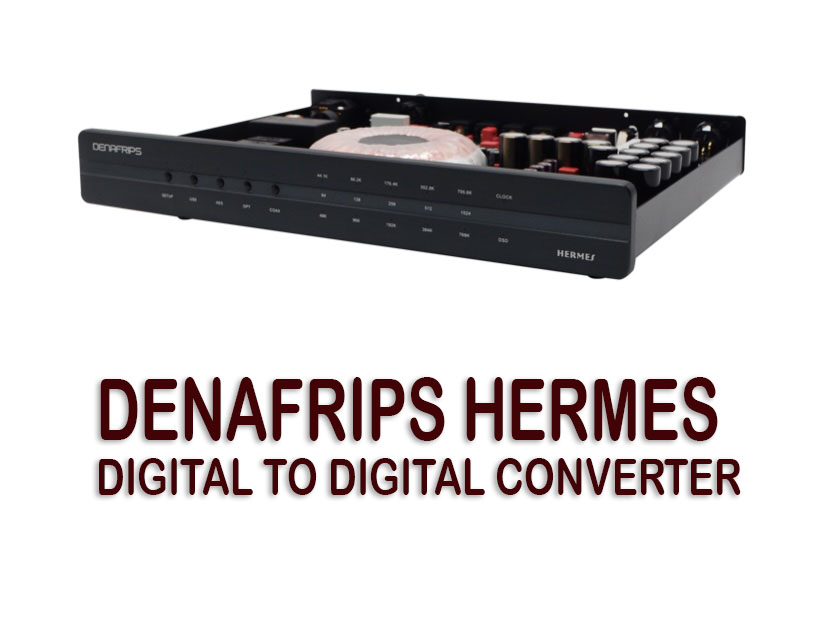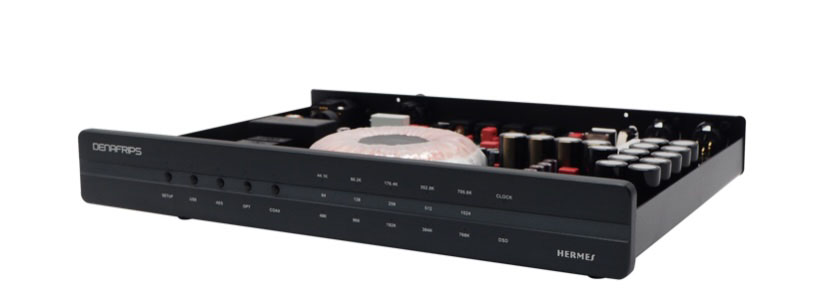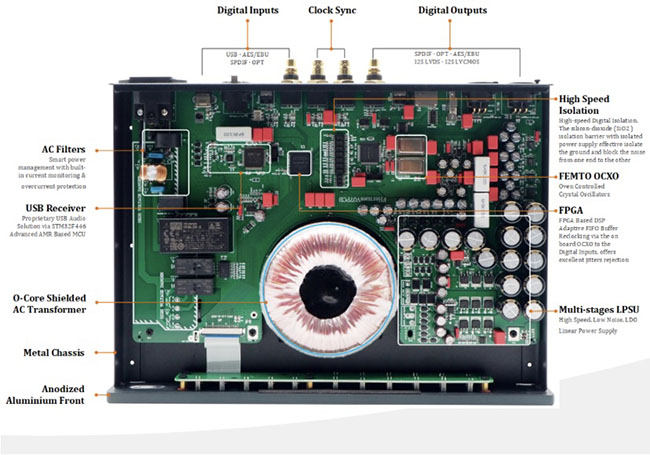Denafrips Hermes D to D converter by Richard Willie

 Many find that vinyl records have a sound that is natural, alive, and relaxed all at the same time. This review isn’t about vinyl records – this review is about the Denafrips Hermes Digital to Digital Converter (“DDC”). Functionally, the Hermes cleans up a digital audio stream and sends an improved signal to a DAC, sweeping back the layers of haze in digital music in the process. Rather than imprint a sound signature of its own, like many pieces of analog equipment, the Hermes seems to accentuate the character inherent to the DAC it is feeding, which for this review is the PS Audio DirectStream DAC (known for its smooth, relaxed, and analog-like sound). With the Hermes in the audio chain, the PS Audio DirectStream DAC becomes a better version, exuding a cleaner, more focused, natural, and alive sound. A sound perhaps best characterized as being more like vinyl.
Many find that vinyl records have a sound that is natural, alive, and relaxed all at the same time. This review isn’t about vinyl records – this review is about the Denafrips Hermes Digital to Digital Converter (“DDC”). Functionally, the Hermes cleans up a digital audio stream and sends an improved signal to a DAC, sweeping back the layers of haze in digital music in the process. Rather than imprint a sound signature of its own, like many pieces of analog equipment, the Hermes seems to accentuate the character inherent to the DAC it is feeding, which for this review is the PS Audio DirectStream DAC (known for its smooth, relaxed, and analog-like sound). With the Hermes in the audio chain, the PS Audio DirectStream DAC becomes a better version, exuding a cleaner, more focused, natural, and alive sound. A sound perhaps best characterized as being more like vinyl.
Description
 It would be difficult to describe the Denafrips Hermes without first discussing the problem it helps mitigate – Jitter. Without getting overly technical, digital music travels to a Digital to Analog Converter (DAC) via digital data stream, consisting of a periodic signal that is often depicted graphically as a square wave, which the DAC then interprets as a series of either ‘1’s’ or ‘0’s.’ Jitter, then, is any undesired deviation in the timing in that periodic signal. The Denafrips Hermes is a DDC that receives a digital signal data stream from a source (such as a computer, CD player, etc.), buffers and re-clocks that data stream, and delivers a resultant signal with significantly mitigated Jitter.
It would be difficult to describe the Denafrips Hermes without first discussing the problem it helps mitigate – Jitter. Without getting overly technical, digital music travels to a Digital to Analog Converter (DAC) via digital data stream, consisting of a periodic signal that is often depicted graphically as a square wave, which the DAC then interprets as a series of either ‘1’s’ or ‘0’s.’ Jitter, then, is any undesired deviation in the timing in that periodic signal. The Denafrips Hermes is a DDC that receives a digital signal data stream from a source (such as a computer, CD player, etc.), buffers and re-clocks that data stream, and delivers a resultant signal with significantly mitigated Jitter.
Jitter is an inevitable consequence of the analog hardware underlying digital systems. The sources of Jitter may be varied but could include variances in processing loads, random sources of electromagnetic radiation, and perhaps most notably, noise in the power supply. Some digital sources (like my 2012 MBP) suffer from greater levels of Jitter than perhaps a CD player or digital ethernet bridge. But no matter the source, it will have some level of Jitter in its output signal. The Denafrips Hermes serves as an intermediary between the digital source and the DAC. In speaking with Denafrips engineers, I learned that Jitter over a USB cable is difficult to correct; a separate DDC helps to minimize Jitter by minimizing the impact of the USB interface between the computer and the DAC, correcting for poor computer power supplies, and providing a superior reference clock when sending the digital audio stream to the DAC.


In terms of design aesthetics, the Denafrips Hermes is simple and unobtrusive. Along the front are a series of push-button input selectors, with red LED indicator lights (a departure from the industry-standard blue). Around the back of the unit are an array of digital inputs, including USB, AES/EBU, Coaxial via RCA, and Toslink. Outputs are the same as the inputs but trade the USB for dual I2S outputs.
Firmware
 The I2S output is not standardized among audio manufacturers. Each manufacturer may implement it in different ways. As I hinted before, one of the motivating reasons I wanted to experiment with this particular product was its ability to utilize the Hermes’ I2S outputs with my PS Audio DirectStream DAC. While the initial version of the firmware worked with PCM signals to my DAC, it did not work well with DSD files, and the other outputs on the Hermes were limited to a resolution of DSD64. Possibly the most distressing aspect of this initial firmware was the fact that it would not work with an Apple M1 computer.
The I2S output is not standardized among audio manufacturers. Each manufacturer may implement it in different ways. As I hinted before, one of the motivating reasons I wanted to experiment with this particular product was its ability to utilize the Hermes’ I2S outputs with my PS Audio DirectStream DAC. While the initial version of the firmware worked with PCM signals to my DAC, it did not work well with DSD files, and the other outputs on the Hermes were limited to a resolution of DSD64. Possibly the most distressing aspect of this initial firmware was the fact that it would not work with an Apple M1 computer.
After discussing the issue with Alvin Chee, the owner of Vineshine Audio and exclusive distributor of Denafrips products, I learned of a new and updated version of the firmware. While the update process was a bit more involved than other audio products I have used (and could only be accomplished with a Windows computer), the results were entirely successful. The Apple M1 issues were completely resolved. Importantly, I listened to DSD256 files over an I2S connection, which had been an option previously unavailable to me on the PS Audio DirectStream DAC.
Importance of the I2S Output
The Hermes has a variety of input and output options to choose from. The initial version of the firmware that I used with this unit was not fully compatible with my DirectStream DAC but was remedied with a firmware update. Compared to the AES/EBU and Coaxial RCA outputs, music via the I2S connection seemed to have a bit of sparkle, realism, and glow that the other connections missed. The difference was subtle and somewhat difficult to describe, but very definitely there. While many of the Hermes benefits are realized using the AES/EBU or Coaxial RCA outputs, I found that the DirectStream DAC sounded the best when using the I2S connection.
When considering a review of the Hermes, it was perhaps the I2S output connection that I found the most fascinating. While PS Audio does make products with an I2S output (that by all accounts perform remarkably well), they do not have a streamer that supports Tidal and Qobuz (yet). This was particularly curious because PS Audio’s final firmware update to the DirectStream DAC (Sunlight) unlocked the ability to stream Quad Rate DSD files. However, the ability to play these types of files was very nearly a moot point because it was available only over the I2S connection.
The Denafrips Hermes is the bridge that unlocks the PS Audio DirectStream DAC’s full performance. Much of the music I listen to is streamed from Tidal or Qobuz via Roon on a MacBook Pro. I especially love the convenience and sheer magnitude of these digital libraries and the increasing quality of the audio streams. But, as much as I like Roon and streaming from a computer, there are few (if any) streamers out there that both support Roon and I2S streaming simultaneously. The Denafrips Hermes has turned out to be a nearly perfect bridge between Roon and the PS Audio DirectStream DAC and has masterfully extracted the last bits of performance from PS Audio’s now fully matured DirectStream DAC.
Arguably, the Denafrips Hermes (or perhaps Gaia) is the product that PS Audio should have created itself. With its updated firmware, the Hermes exhibits the kind of synergy typically shared within a single manufacturer’s product line. While Denafrips did not have the DirectStream DAC in mind during product development (as evidenced by the initial firmware), the fortuitous and unexpected synergy of the Denafrips/PS Audio combination is difficult to ignore.
Observations
 One of the striking things about the Denafrips Hermes is how it puts digital sources of disparate quality on near parity with one another. I have a two-channel system, but it gets used for the occasional movie from an Oppo Blu-ray player or Apple TV. When watching Blu-rays, I generally use the 2-channel analog output from the player into a preamp and then to the rest of the system. Traditionally I avoid Toslink connections, but I was curious how well the Hermes would clean up the signal.
One of the striking things about the Denafrips Hermes is how it puts digital sources of disparate quality on near parity with one another. I have a two-channel system, but it gets used for the occasional movie from an Oppo Blu-ray player or Apple TV. When watching Blu-rays, I generally use the 2-channel analog output from the player into a preamp and then to the rest of the system. Traditionally I avoid Toslink connections, but I was curious how well the Hermes would clean up the signal.
For this review, instead of outputting the Toslink directly from the Oppo to the DAC, which I knew from prior experience would be completely uninspiring, I connected the Oppo to my television via HDMI, then ran a Toslink from my television to the Hermes. This is one of the worst-case jitter scenarios I could think of, but I was amazed at the degree to which the Hermes cleaned up the sound. To my surprise, it sounded better than running a completely analog signal from the Oppo directly to the amplifier. A similar result ensued when using the Apple TV and its Toslink connection. Typically movies via Apple TV have never impressed. Still, with the Hermes cleaning up the digital audio stream, the Apple TV sounded pretty good (sadly, the same could not be said of Apple Music, which is still bad). This ability to clean a Toslink digital audio stream was unexpected and spoke volumes about what the Hermes is capable of.
I noticed similar results when using various digital filters in Roon. In general, digital equalizers suck the life out of music. I have never come across a digital equalizer, room correction, convolution filter, or upsampler that I thought did more good than harm (though HQ Player has been intriguing to me in recent months). There just seems to be something lost in the process, no matter how minor the change. On some music, such as highly processed pop music, the loss may not be as noticeable as an acoustic recording. But, there always seems to be a trade-off.
The Hermes helps mitigate the negative impact of using some of these digital filters. When using Roon’s EQ, the sound quality seems to decline with the strength of the filter being used, but with the Hermes in the digital audio chain, much of that negative effect can be mitigated. Using Roon’s EQ with Hermes can produce comparable (or slightly better) results than turning EQ off and not using the Hermes at all.
The results were similar when using Roon’s upsampling filters. I have spent significant periods of time (prior to receiving the Hermes for review) testing various upsampling settings within Roon. I’ve gone back and forth on the benefits and drawbacks of upsampling. While I have found Roon upsampling settings that I have found to be “livable,” I have yet to find an upsampling setting within Roon that I think is “better” than simply using an unprocessed signal. However, with Hermes mitigating the negative effects, new doors have been opened for upsampling. Of particular interest for me is the myriad of upsampling options of HQ Player used in conjunction with Roon. Although, beyond the scope of this review, I found upsampling with Roon and HQ player through the Hermes to give some promising results.
Listening

My principal point of reference is the PS Audio DirectStream DAC, known for its smooth, relaxed, almost vinyl-like sound. While the Hermes does excellent things for this DAC, the DirectStream never becomes clinical or loses its vinyl-like charm. On the contrary, these characteristics become more accentuated, bringing out even more of what I love most about the DirectStream DAC.
When the Hermes is in the system, the PS Audio DirectStream DAC sounds like a haze has been lifted, with a much more focused and natural sound. The Hermes helps the highs sound more well-defined and crisp, and there seems to be more air and space around the music. The bass is cleaned up, a bit tighter, and less sloppy. Without the Hermes, all of the little sounds are still there, but they aren’t quite as convincing or as natural as when it is in use. The Hermes seems to bring out a bit of sparkle and life in the music that accentuates that analog magic that the DirectStream DAC is already known for. In short, the Hermes helps the DirectStream sound more natural, inviting, and alive.
One of the interesting things that came up during my review process was an informal comparison to vinyl records. One of the reasons some are so fond of PS Audio’s DirectStream DAC is its analog sound. However, I’ve always felt that even an entry-level turntable with quality vinyl beat out the DirectStream DAC in several respects. For example, in previous comparisons (without the Hermes), I’ve left the listening session always feeling the return to digital music was lacking a bit of life. The Hermes has somewhat changed that perspective.
Comparisons between vinyl and digital systems almost have too many variables to be meaningful. Despite the incendiary nature of this topic, I wish only to make one simple observation. With the Hermes cleaning up the digital audio stream, my digital collection competes favorably with my (entry-level) vinyl setup. Before the Hermes was introduced to my system, listening to vinyl records was (generally) my preference. However, the Hermes has tilted the scales back in favor of the digital system.
 Daft Punk’s 2013 “Random Access Memories” (exclusively licensed to Columbia Records and distributed by Sony Music Entertainment) is a great example. Without the Hermes, I unquestionably prefer the vinyl version. However, the digital version is cleaner and more well-defined than the vinyl version with the Hermes. Still, beyond that, there are other differences in mastering the recordings themselves. Now here’s the interesting part: by carefully applying Roon’s upsampling filters, minor EQ adjustments, and volume matching, the vinyl pressing and the 88.2 kHz 24-bit recording can be made to sound very close to one another; much closer than I anticipated they could be. Where I could easily demonstrate the difference in sound between the vinyl and digital system to houseguests and enthusiasts, the Hermes (with digital matching) made the sound close enough that most of my guests found the recordings difficult to distinguish.
Daft Punk’s 2013 “Random Access Memories” (exclusively licensed to Columbia Records and distributed by Sony Music Entertainment) is a great example. Without the Hermes, I unquestionably prefer the vinyl version. However, the digital version is cleaner and more well-defined than the vinyl version with the Hermes. Still, beyond that, there are other differences in mastering the recordings themselves. Now here’s the interesting part: by carefully applying Roon’s upsampling filters, minor EQ adjustments, and volume matching, the vinyl pressing and the 88.2 kHz 24-bit recording can be made to sound very close to one another; much closer than I anticipated they could be. Where I could easily demonstrate the difference in sound between the vinyl and digital system to houseguests and enthusiasts, the Hermes (with digital matching) made the sound close enough that most of my guests found the recordings difficult to distinguish.
Before I upset the apple cart too much (as I said before, the comparison has so many variables as to be almost meaningless), the point I am hoping to make it simple: my digital system (streamed via USB, or via PS Audio’s Bridge II) has never been quite on par with an entry-level turntable, with new, clean, vinyl recordings. The Hermes puts these two in the same ballpark is remarkable to me. While detractors may (correctly) argue that I could easily make any number of upgrades to the turntable to make it sound significantly better, that’s not the point. Here, the Hermes has bridged a gap and made my PS Audio DirectStream DAC sound in a way that I didn’t think was possible before the audition.
Give Life Back to Music on Daft Punk’s “Random Access Memories” (mentioned above) may as well be the title of this review. This is a perfect opening track for the album, as it opens dramatically and sets the tone of the rest of the album with a groovy, retro, 70’s disco feel. The opening cymbal crashes have a new clarity through the Hermes, with a greater sense of air around them. Everything seems to be in greater focus than when streaming from the MBP alone, and the music seems to have a greater sense of ease (much like the vinyl version) that allows the listener to relax into the groove. Without a doubt, the Hermes seems to add a bit of life to the digital track.
 Don Grusin’s Out of Thin Air, released by Octave Records, is an album that has steadily grown on me from the moment I first listened to it. I prefer the DSD64 version of the album and frequently play the “Hermano Hilado” track, which is a good album representing this jazz-themed piano solo album. As tired as the analogy is, the Hermes seems to clear off a layer of haze from digital audio recordings, almost like cleaning a dirty window. Through the Hermes, Grusin’s playing seems more natural, clear and evoking a distinct emotion of purity. Though sadly, I have not had the opportunity to compare this to a vinyl pressing, the DSD recording of this album is simply beautiful. It seems a little more clear, realistic, natural, and (again) alive through the Hermes.
Don Grusin’s Out of Thin Air, released by Octave Records, is an album that has steadily grown on me from the moment I first listened to it. I prefer the DSD64 version of the album and frequently play the “Hermano Hilado” track, which is a good album representing this jazz-themed piano solo album. As tired as the analogy is, the Hermes seems to clear off a layer of haze from digital audio recordings, almost like cleaning a dirty window. Through the Hermes, Grusin’s playing seems more natural, clear and evoking a distinct emotion of purity. Though sadly, I have not had the opportunity to compare this to a vinyl pressing, the DSD recording of this album is simply beautiful. It seems a little more clear, realistic, natural, and (again) alive through the Hermes.
PS Audio’s final firmware release for the DirectStream DAC, named “Sunlight” after Colorado’s Sunlight peak, unlocked the ability to play Quad Rate DSD recordings, but only through the I2S connection. I frequently peruse the DSD catalog at NativeDSD.com but have never committed to purchasing a Quad Rate recording because there has simply not been a point. The Hermes represents a few existing methods to play these remarkable recordings on the DirectStream DAC. For this review, I listened to the acclaimed album The Sweetest Sound, Angelo Verploegen, Ed Verhoeff & Eric Van Der Westen, released by Just Listen Records. This album was recorded in DSD256 and has not been processed in DXD or PCM during mastering, earning this NativeDSD’s “Pure DSD” moniker. “Isfahan” is one of my favorites from this album, with Verploegen’s flugelhorn, Verhoeff’s guitar, and van der Westen’s double bass, playing a sweet melody that is honest and natural. There’s a great sense of space on the album, and it stands as one of the better recordings I currently own. Listening to this album without the Hermes automatically requires some downsampling of the audio stream, making comparisons challenging. However, it highlights the fact that the Hermes simply unlocks many albums that would not be otherwise accessible to DirectStream DAC owners.
Conclusion
The Denafrips Hermes is a piece of equipment that helps bring out the full potential of the DAC it is feeding. Jitter is a problem that is well-documented in the audio industry, and many manufacturers have made leaps and bounds strides in ameliorating this issue in the past ten years. However, as the Hermes demonstrates, there is still progress to be made. There may be a day when the Hermes becomes antiquated as the DAC’s of the day become something that cannot be added upon. But, at least for the current generation of DAC’s, the Hermes appears to add real value to a digital audio system. For me, the benefits are enough that I don’t have to question the purchase. I am keeping the review sample.
Richard Willie

Price USD $1749
Specifications
D/D Converter
Proprietary FPGA DSP Processing Architecture
FIFO Buffer and Reclock with Internal Crystal
Precision Oven Controlled Crystal Oscillator OCXO
Optical Isolated All Digital Input Interfaces
Proprietary USB Audio Solution via STM32F446 Advanced AMR Based MCU
Licensed Thesycon USB Driver For Windows Platform
Driverless On Mac & Linux
Dual AES/EBU Output Supported
External Clocks Input Supported
DSD DSD64 (DoP) on Coax/AES/Opt Input & Output
Upto DSD512 On USB Input & I²S Output
PCM 24bits / 44.1, 48, 88.2, 96, 176.4, 192KHz On All Input & Output
Up to 768KHz On USB Input & Up to 384KHz on I²S Output
Digital Input Coax SPDIF via RCA
TOSLink x 1
AES/EBU x 1
USB2.0 Type B
External Clock Input 45.1548MHz
49.152Mhz
Digital Output Coax SPDIF via RCA
TOSLink x 1
AES/EBU x 2
I²S HDMI LVDS Standard
I²S RJ45 LVCMOS Standard
AC Power Requirement 100-240VAC, 50/60Hz (Worldwide Voltage)
Power Consumption ≤20W
Dimension 330W x 240D x 50H mm (Feet +18mm)
Weight 4.5 Kg
Color Black
Warranty 36 Months
Website: https://www.denafrips.com/
2 thoughts on "Denafrips Hermes D to D converter by Richard Willie"
Leave a Reply
Stereo Times Masthead
Publisher/Founder
Clement Perry
Editor
Dave Thomas
Senior Editors
Frank Alles, Mike Girardi, Russell Lichter, Terry London, Moreno Mitchell, Paul Szabady, Bill Wells, Mike Wright, and Stephen Yan,
Current Contributors
David Abramson, Tim Barrall, Dave Allison, Ron Cook, Lewis Dardick, John Hoffman, Dan Secula, Don Shaulis, Greg Simmons, Eric Teh, Greg Voth, Richard Willie, Ed Van Winkle, Rob Dockery, Richard Doran, and Daveed Turek
Site Management Clement Perry
Ad Designer: Martin Perry







Joe Mickens
I had tried the Iris which worked with my Holo May
3 KTE and was a d3cent improved ment
,the stinger almost the same.
The Hermes 12th is noticeably better then the Hermes in this review , more defined and depth of image ,even stronger bass ,well worth the ask8ng $1299
Even withethe excellent pontus 15 ,the Hermes 12
With a Wire world silver sphere great I2S cable
Takes good dacs that much closer to being at the event.
I must 2 nd that, I had the Iris ,and no comparison ,not saying the Iris does not clean up the stream it most certainly does but the Hermes 12 we tested on a bunch of dacs and maybe being much bigger having much better filtering and far better dual oven clocks
The dacs with quality 110 ohm , and better still I2S
Just added much more richness and organic realism bas,midBass really improved the dac be it Holomay,Terminator or PS audio all noticably improved for the better for under $1300 a easy choice.